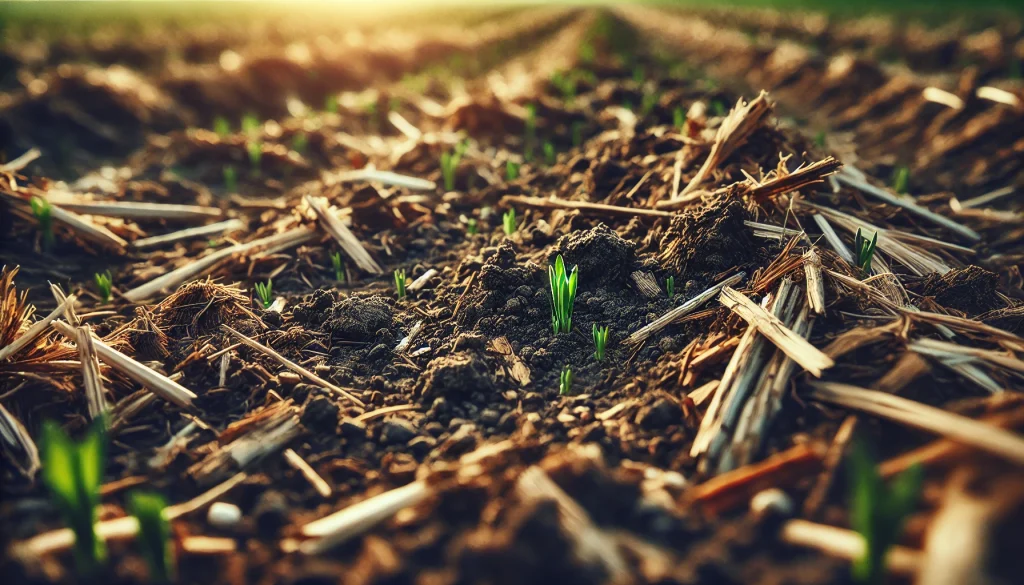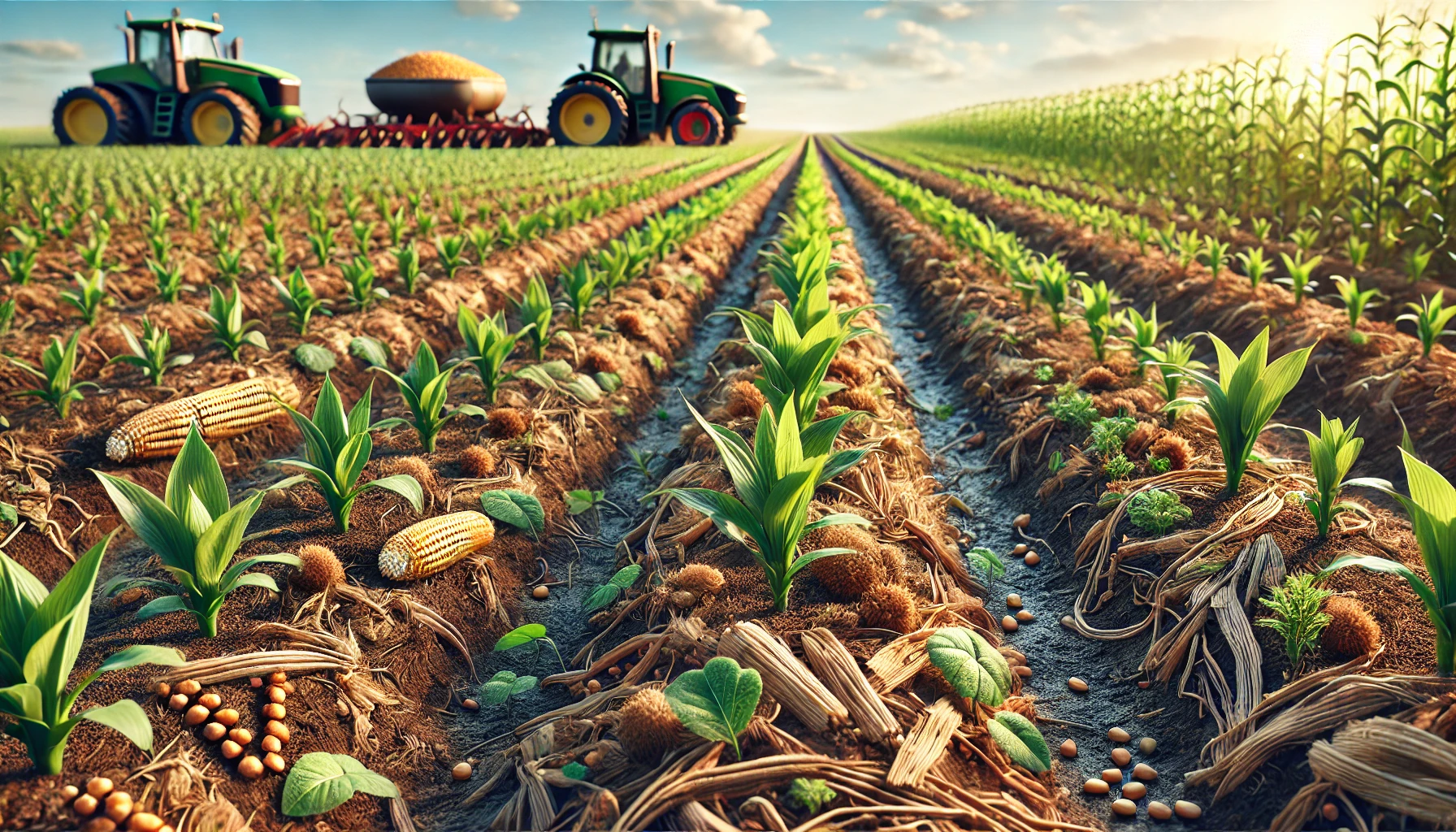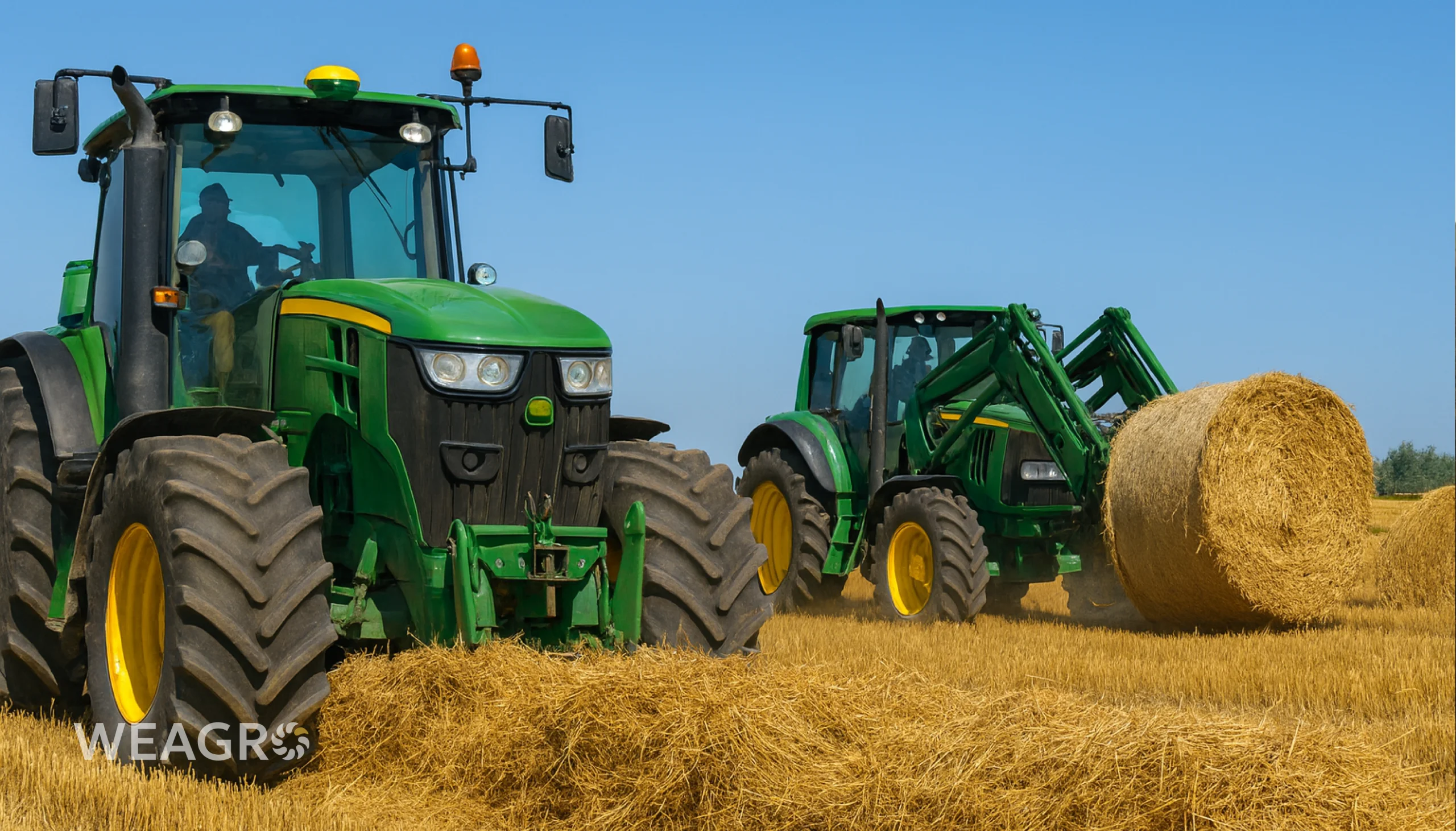No-till technologies, or zero tillage technologies, are gaining increasing popularity among Ukrainian farmers. This innovative farming system not only reduces production costs but also preserves soil fertility and reduces environmental impact. In this article, we will explain what No-till is, its advantages and disadvantages, how to properly implement it, and its development prospects in Ukraine.
What are No-till Technologies

No-till is a farming system that involves minimal mechanical impact on the soil. Derived from the English phrase “no tillage,” it eliminates plowing, cultivation, harrowing, disking, and other traditional methods. Instead, the soil surface is constantly covered with a layer of shredded plant residues (mulch) that protect it from erosion, retain moisture, and gradually transform into organic fertilizers.
Thus, zero tillage means:
- complete elimination of mechanical soil tillage;
- permanent plant cover on the surface (living plants or mulch);
- scientifically based crop rotation;
- use of plant residues instead of organic fertilizers;
- prohibition of burning stubble and other plant residues;
- application of mineral fertilizers and plant protection products only during seeding with special direct seeders that minimally disturb soil structure.
Zero tillage technology originated in the USA in the 1940s, with its active global spread beginning in the 1960s. According to a
What are the reasons for such popularity of No-till technology? First and foremost, it significantly reduces production costs and increases crop production profitability. According to research, No-till implementation provides significant cost savings compared to traditional technology. For example, fuel savings amount to approximately 13.5 l/ha annually, which at a diesel fuel price of $4.75 per gallon results in savings of about $42 per hectare. Research in Paraguay showed that total cost savings for soybean cultivation were $233 per hectare, and for corn – $108 per hectare.
Farmers Weekly calculated that equipment and labor costs on farms using No-till were 22% lower compared to traditional farms. According to the same data, No-till systems provide working capital savings of £260/ha (approximately $642/ha) and reduce variable costs by £74/ha (about $183/ha). These savings are achieved through reduced fuel consumption, decreased equipment depreciation, and improved labor productivity.
Read also: Remote sensing of the Earth: what it is, types and prospects
Advantages and Disadvantages of No-till Technology
Like any other technology, the No-till system has its strengths and weaknesses. Before implementing it on your farm, it’s worth carefully weighing all pros and cons, considering climate characteristics, soil conditions, technical resources, and staff qualification levels.
Advantages of No-till Technology
The key advantages of the No-till farming system, besides resource savings, are:
- prevention of erosion processes through permanent plant cover on the soil surface;
- preservation and accumulation of soil moisture, which is especially important in conditions of insufficient moisture;
- soil enrichment with organic matter and restoration of its natural fertility;
- expansion of biodiversity, activation of beneficial soil microorganisms;
- reduction of carbon dioxide emissions and mitigation of climate change impacts.
All these factors combined contribute to increased crop yields, reduced production costs, and increased crop production profitability. According to research conducted in Ukraine, the efficiency of crop utilization under the no-till system is 15% higher than under traditional technology.
Crop Rotation in No-till Technology
Scientifically based crop rotation is one of the cornerstones of success in No-till. The essence is to select a sequence of plants capable of optimally using environmental resources, suppressing weed growth, and improving soil fertility.
The advantages of well-planned crop rotations in zero tillage technology include:
- improvement of field phytosanitary conditions by breaking disease and pest development cycles;
- optimization of plant mineral nutrition, increased fertilizer use efficiency;
- increased proportion of legumes and green manure crops capable of fixing atmospheric nitrogen and loosening soil;
- better soil moisture utilization through alternating plants with different root system depths and types;
- reduced field weed infestation and decreased herbicide requirements.
Proper crop rotation allows harmonious combination of main commercial crops with intermediate and cover crops, creating continuous plant cover. This, in turn, prevents soil erosion and degradation, which is a key advantage of zero tillage technology.
Read also: Soil: What It Is, Types, and Its Fertility
Disadvantages of No-till Technology
Despite all its advantages, zero tillage has certain challenges that should be considered before implementing this system:
- need for specialized equipment (direct seeders, sprayers) and highly qualified personnel;
- possible increase in weed infestation and phytosanitary problems during the transition period, requiring herbicide use;
- slower soil warming and drying in spring due to mulch cover;
- necessity for careful crop rotation planning and plant residue management;
- risk of insufficient plant nutrition due to nutrient immobilization by microorganisms during mulch decomposition.
These and other problems can be successfully resolved through a systematic approach and consistent steps toward mastering zero tillage technology. Particularly important are planning optimal size and distribution of plant residues, alternating crops with different root system types and sowing dates, and precise placement and local application of fertilizers.
The online service WEAGRO is ready to provide consulting support and supply agricultural producers with everything necessary for implementing innovative no-till technology. Convenient agricultural credit tools will enable the purchase of fuels and lubricants and plant protection products on favorable terms. We believe that zero tillage is an investment in the future. Therefore, we are ready to support farmers who strive to preserve soil fertility and increase their business efficiency by implementing no-till technology.
Application of Agrochemicals in Zero Tillage
The transition to no-till initially increases herbicide use, but their need decreases over time. Effective agronomic weed control measures include:
- sowing cover crops;
- increasing the seeding rate of the main crop;
- avoiding autumn nitrogen fertilizer application;
- livestock grazing or mowing for green manure.
Disease and pest control requires an integrated approach using crop rotation, resistant varieties, and biological and chemical protection methods. The number of fungicide and insecticide treatments usually does not exceed traditional technology indicators.
Plant Residues in No-till Technology
Plant residues, or mulch, are a key component of a successful No-till system. They perform a complex of important functions:
- erosion protection;
- moisture retention;
- weed suppression;
- soil biota nutrition;
- nutrient release;
- soil enrichment.
The previous crop also affects seeding characteristics in No-till technology. The main goal is to ensure seed contact with moist soil without disturbing the mulch layer.
Implementation of No-till Technology
Implementing a zero tillage system is a gradual process that requires effort and time. Experts recommend carrying it out in several stages:
- Soil preparation. Initially, soil analysis should be conducted, field surface leveled if necessary, and perennial weeds eliminated.
- Equipment acquisition. Special seeders capable of planting in soil covered with plant residues are needed for no-till crop seeding.
- Transition to crop rotation. The rotation should include cover crops that quickly form plant cover and suppress weeds.
- Crop cultivation. Seeding should only be done in well-warmed and dried soil. Seeding rates, planting depth, and other parameters may differ from traditional ones.
- Plant residue management. Shredded plant residues are evenly distributed on the soil surface. They must not be plowed under or burned.
- Weed, pest, and disease control. This is achieved using herbicides, high stem density, and crop rotation.
Common mistakes when implementing No-till technology:
- seeding in oversaturated soil;
- insufficient shredding and uneven distribution of plant residues;
- excessive soil compaction due to improper equipment movement;
- non-compliance with scientifically based crop rotation;
- expecting quick returns in the first 2-3 years after transitioning to the new system.
Complete transition from traditional farming to the No-till system can take 5 to 7 years. During this period, soil healing and restoration occur, experience is gained, and initial costs are recovered. When implementing No-till, consistency, patience, and willingness to learn are very important.
Prospects for No-till Technology Development in Ukraine
The technology is indeed gaining popularity in Ukraine, especially in arid regions. In the Steppe zone, about 4% of lands, or 250 thousand hectares, are under the No-till system.
The leaders in technology implementation are:
- Donetsk region – 12%.
- Zaporizhzhia region – 7%.
The spread of zero and minimal technologies is hindered by several factors:
- poor information for farmers about No-till principles and advantages;
- conservatism and distrust of unusual farming methods;
- need for significant initial investments in new equipment and staff training;
- insufficient state support for innovative technologies in agriculture.
Therefore, wider implementation of the technology in Ukraine requires educational efforts from the agronomic community, state consultative and financial assistance, and farmers’ openness and readiness to change usual approaches. Given the positive experience of advanced farms and global trends in organic and soil-protective farming development, No-till is the future in our country as well.
The online agricultural credit service WEAGRO will help agricultural producers acquire high-quality equipment and fertilizers for effective implementation of innovative agricultural technologies. Thanks to our online tools, you can not only transition to zero technologies but also optimize costs, increase yields, and preserve the most valuable resource – fertile soils.









